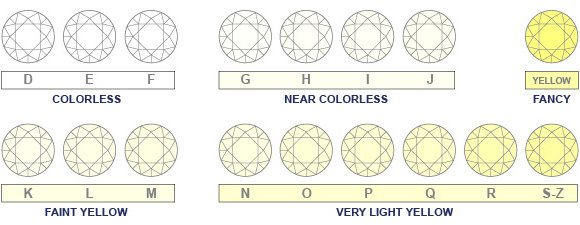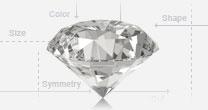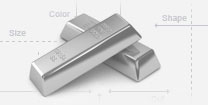- Diamonds
- Engagement
- Jewelry
- Education
- Learn about Diamonds
- Learn about Metals
- What to expect when buying a ring
- Custom Design Process
- The Diamond 4 C's
- How To Care For Your Jewelry
- How To Plan A Wedding
- Picking an Engagement Ring
- Top 10 Ways To Propose
- The Meaning Behind Shapes and Colors of Diamonds
- Advice for Grooms
- The Natural History, Mythology, and Symbolism of Popular Gemstones
- The Bridal Style Checklist
- The Economics of Engagement Rings
- How to Keep Your Diamonds Safe from Theft or Damage
- How to Create the Perfect Christmas Proposal
- The Secret Guide for Authentic Engagement Photos
- How to Plan the Perfect Marriage Proposal
- Best Seasons to Get Married In
- About Us
Diamond Color Guide
A diamond's color refers to a diamond's transparency, or lack of color saturation. Almost all diamonds contain some degree of color impurity caused by traces of boron, nitrogen, hydrogen or other elements. Most diamonds are affected primarily by nitrogen traces, which create pale yellowish or brownish tints.
When shopping for a diamond, be aware that the most valuable diamonds have the least amount of color. It is important to note that there is a category of diamonds known as fancy diamonds which are actual colored diamonds. These include but are not limited to pink diamonds, blue diamonds, and even yellow diamonds.
What Is The Right Color For Me?
Even though the differences in apprearance between colorless and near-coloreless diamonds can be subtle, the differences in price are often considerable. If you are sensitive to low color grades, then a higher color (D-F) may be in order. If you have difficulty differentiating between different color grades, then you may want to consider a nearly colorless diamond.
The brilliance of the round brilliant diamond affords you more flexibility with the color grade because the brilliancy of the shape makes the color less detectable. With the case of the round brilliant, anything over I color is typically adequate, and will appear colorless to the untrained eye unless held up against a diamond that is at least three color grades above it, such as an E or F colored diamond. In this context you may want to consider the hundreds to thousands of dollars that you can save by going with a lower color diamond. For example, you can use the difference towards the carat weight and get a larger diamond, or consider a diamond with a better cut, thus providing you with a more sparkling and dazzling stone.
If you are looking to mount the diamond into yellow gold you can enjoy greater flexibility with your chosen color. The diamond will not appear as yellow when mounted up against the yellow gold because of the lack of contrast. Even get a diamond with a J or K will still appear to be colorless to the untrained eye under these circumstances.
Diamonds with pointed ends, specifically radiant, marquise, trillion, pear and sometimes even princess shaped diamonds tend to focus the color on these points. It is usually best to stay with a color grade of H and higher when choosing these shapes. In a pronged setting, the prongs will usually hide this color concentration.
Color Grading
Diamonds are graded for color by examining them face-down under a controlled light. The diamond's color is then compared to the diamond Master-Set that have predetermined and calibrated colors.
The Gemological Institute of America's (GIA) created the standard for industry's standard for diamond color grading. The GIA's color grading system begins with D, the whitest color, and continues through the alphabet to Z, for stones that are yellowish or brownish. Before the universal diamond color grading standard was created there were several other diamond color scales were being used by the international diamond community. GIA's intended to differentiate their new system from the others and did so by using the letters D-Z that have never before used for diamond grading.

Diamond Color
D: Completely Colorless. This is the highest color grade a diamond can receive. D graded diamonds are very rare and highly priced.
E, F: Colorless and very transparent. It is very difficult to detect the traces of color in an E or F graded diamond. These diamonds are rare and highly priced.
G, H: Nearly Colorless. The color of these diamonds is nearly indiscernible from colorless options unless they are compared to each other side-by-side under a diamond grading light. When face up these diamond appear nearly colorless. These nearly colorless diamonds are still rare, but are less expensive and are considered a good value.
I, J: Nearly Colorless. Color is slightly detectable in these diamonds. The slight amount of color is not easily perceived by the unaided eye once the diamond has been mounted. These diamonds are a terrific value, and consequently compose the majority of diamonds that are used for jewelry production.
K-M: Faint Yellow. Very Noticeable color, eventhough they can still be fiery and beautiful.
N-Z: Very Light or Light Yellow. Extremely Noticeable color. Not fit to be sold as gemstones unless you are looking for dark ambery color in the gem.
What is Fluorescence?
About a third of all diamonds have fluorescence to some extent. Fluorescence causes the diamond to emit a light glow of light the same way that a white T-shirt does when placed under a short-wave UV light. Natural daylight and indoor fluroscent lighting contain small amounts of UV rays that cause the fluorscent diamonds to exhibit this slight glow. The range that a diamond can fluoresce can range from "None" to "Very Strong".
A GIA survey found that fluorescent diamonds were favored over non fluorescent diamonds in both the lower color range AND in the higher colors, (D, E, and F) which are usually discounted by the trade. Many years ago D-F colorless fluorescent diamonds were highly prized and referred to as "blue-white", but sales people abused the term by including any diamond with fluorescence. So, usage of "blue-white" was outlawed by US trade practice laws.
Some diamonds have extremely strong fluorescence and appear oily or cloudy. In direct sunlight some of these diamonds have a strong milky blue cloudiness that makes the stones very dull.
The fluoro effect in some other lighting can be evident as a bluish tint that does not dull the diamond's brightness or fire . Milkiness is not desirable but the GIA study found them to be very rare. They were unable to find enough cloudy stones to do a study from the 26,010 sample they used.










